immune & virus support

free shipping over $100 (USA & Canada)
1-877-937-4372 the pet expert hotline
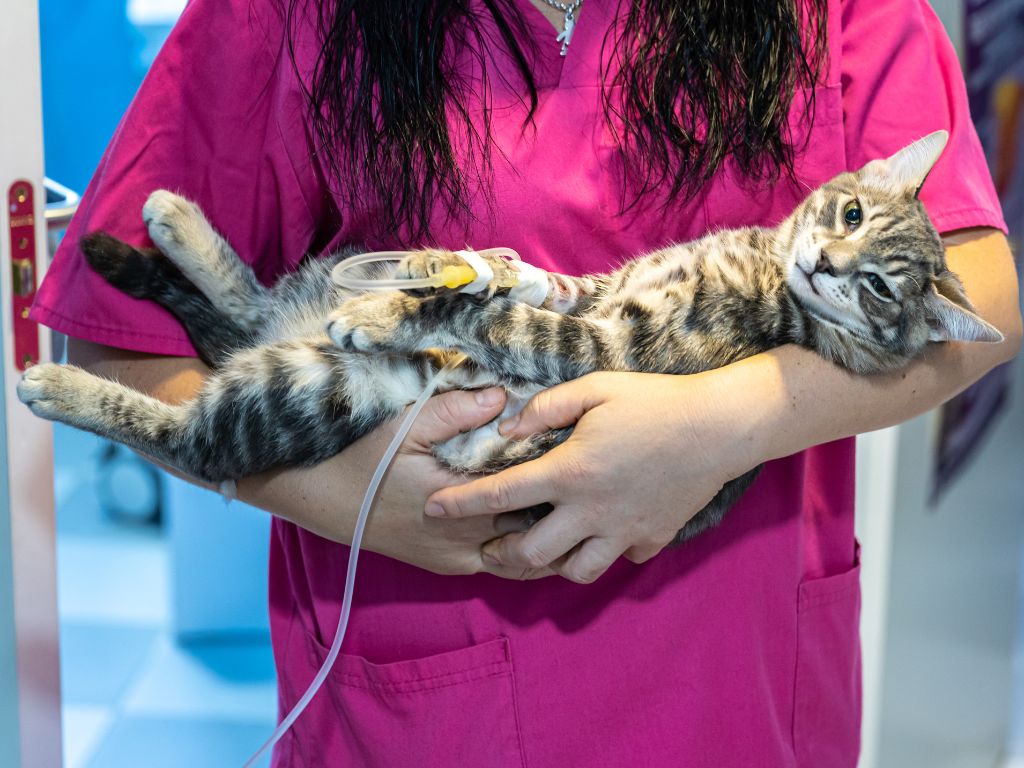
Feline Infectious Peritonitis (FIP) is a viral disease that usually affects younger kittens (under 2 years old) or senior cats. FIP is caused by a mutation of the Feline Coronavirus (FCoV) infection, not to be confused with COVID-19. It is also important to note that studies have shown that FCoV cannot be passed from infected cats to humans.
There are two types of Feline Infectious Peritonitis. The effusive form (wet) happens more commonly and the non-effusive form (dry) is rarer. Both forms of FIP in cats have been associated with abnormalities in the neurological (brain and spine) system, but the non-effusive form appears to involve the nervous system as well. There have been cases of the effusive form of FIP being diagnosed histopathologically in the brains of cats without neurological abnormalities.
Feline Coronavirus (FCoV) is most commonly spread by oral transmission. So places where litter boxes and food bowls are shared, such as catteries or multi-cat households, for example, are at a higher risk of infection. This is mainly due to the fact that infected cats actively shed the virus in feces.
If one or more mutations occur in the FCoV virus, your kitty’s white blood cells may infect other parts of the body with it. When this happens, this virus has mutated into the Feline Infectious Peritonitis Virus (FIPV). The body’s natural inflammatory response is more extreme in areas where infected cells proliferate, often in the abdomen, kidneys, or brain.
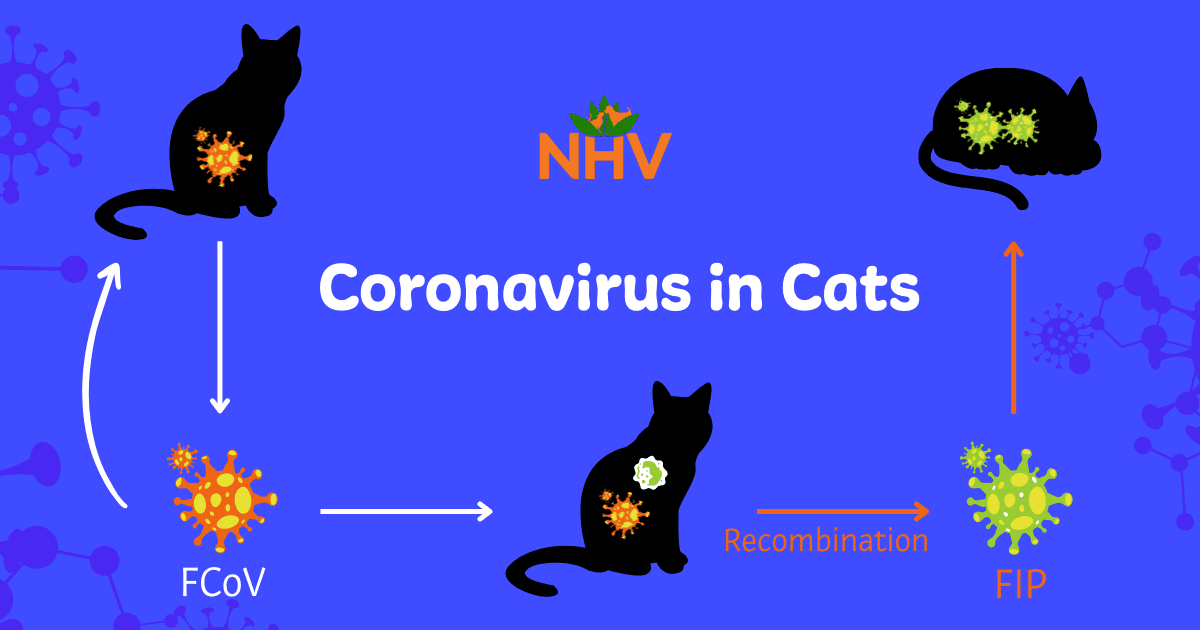
Some signs and symptoms to look out for when your little one is suffering from the non-effusive (wet) form of FIP in cats include:
Your kitty may also present neurological changes, which may include seizures and ataxia (abnormal or uncoordinated movements). However, these specific symptoms develop more slowly than those of the effusive form of FIP in cats.
Signs and symptoms of the effusive form of FIP in cats tend to develop and progress fairly quickly and include the symptoms mentioned above combined with the accumulation of fluid in body cavities, including the chest cavity. Affected cats may develop a pot-bellied appearance due to fluid accumulation in their belly, and if the fluid accumulation becomes excessive, it may become difficult for a cat to breathe normally.
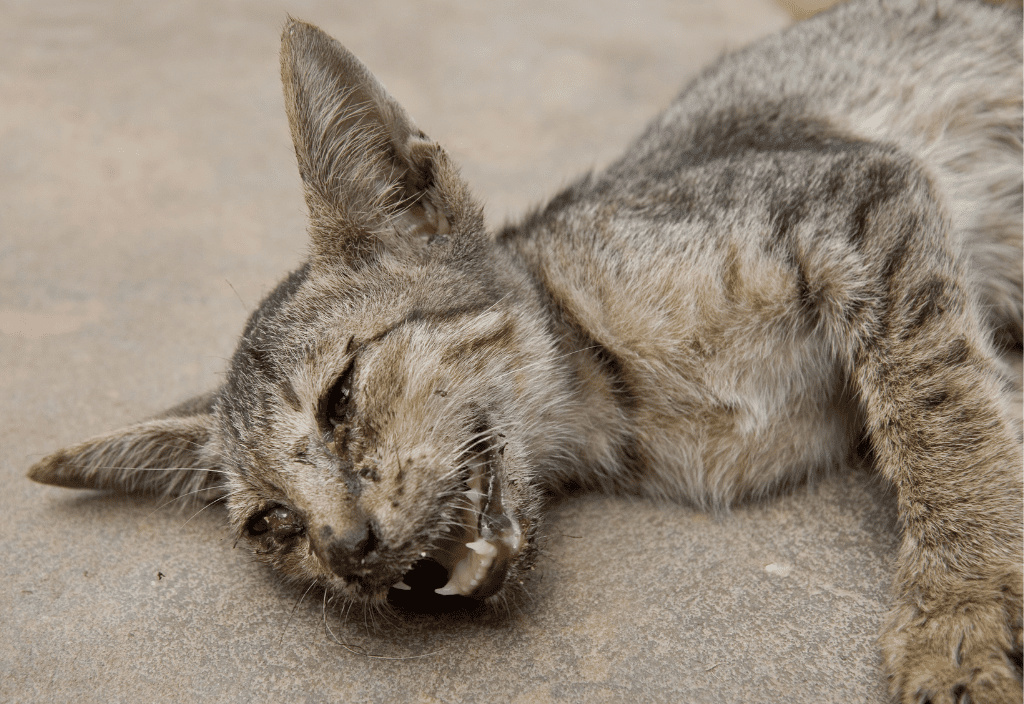
In clinical practice, diagnosing feline infectious peritonitis (FIP) in cats remains a challenge. A lot is required in order to properly diagnose this condition, including a complete history, a physical exam, and adequate variety and interpretation of diagnostic tests remain the cornerstone of antemortem diagnosis.
Unfortunately, since FIP in cats is a fatal disease, there are no confirmed or approved treatments yet. Despite some studies showing the promising effects of antivirals on Feline infectious peritonitis, these treatments are not yet approved by the Food and Drug Administration (FDA). The good news is that there is one FIP vaccine available. However, the efficacy of the vaccine remains unknown and requires more study.
Cats presenting the symptoms listed above often have a very bad prognosis and rapidly get sicker over the days, weeks, and sometimes even months before passing away. So palliative care can offer comfort and support. It is important to keep your kitty as healthy and comfortable as possible, including preventing secondary infections. Good hygiene, a balanced diet, and avoiding overcrowded environments are essential strategies for minimizing the risk of contracting FIP. Litter boxes should be kept clean and away from food and water dishes. Some studies have suggested that cats suspected of having FCov should be kept apart from other cats.
NHV Felimm may be very beneficial for helping to balance your kitty’s immune system against Feline Coronavirus (FCov) and Feline Infectious Peritonitis (FIP). In addition, it helps the body fight infections, encourages detoxication of the lymphatic system, stimulates the appetite, helps improve energy levels, and helps combat upper respiratory tract infections. Felimm can be used as proactive support for kitties that may be at risk for contracting FIP.
NHV BK-Detox contains herbs like burdock, cleavers, and prickly ash that offer support for the liver and kidneys – the organs responsible for detoxifying the body. BK-Detox also helps to support and protect the immune system.
NHV Nature Immuno is a blend of medicinal mushrooms rich in anti-viral and immune-stimulating properties, so it may offer beneficial support for cats suffering from FIP.
NHV Plantaeris helps control diarrhea caused by the Feline Coronavirus (FCov) and may also promote the elimination of the virus from the body. It helps to alleviate spasms and discomfort of the digestive tract and helps to maintain healthy bowel function.
NHV ES-Clear may help to cleanse vital organs and areas affected by FIP. It may also help promote digestion, aid with appetite and help to balance the immune system. ES Clear may also improve your pet’s energy levels and overall quality of life.
immune & virus support

Felimm & BK Detox
bundle and save with pet expert kits
3 month supply for a small to medium size pet.
Natural supplements to aid in the protection against Feline Infectious Peritonitis (FIP).

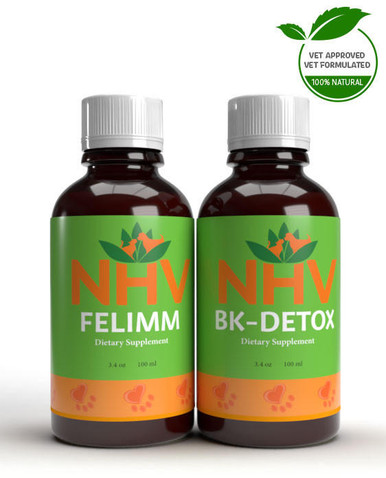
Natural supplements to aid in the protection against Feline Infectious Peritonitis (FIP).

St. John’s Wort – A potent antiviral that helps control viral infections and stimulates your cat’s immune system.
Turmeric – A powerful antioxidant that helps fight the damaging effects of free radicals. It strengthens liver function and contains strong antifungal properties.
Aloe Vera – Contains high levels of vitamins, minerals, amino acids, and other nutrients important for cats with immune disorders.
Alfalfa – Contains high levels of chlorophyll, which works as an antioxidant in your cat's bloodstream. It also contains nutrients beneficial to cats with immune disorders.
Burdock – Helps cleanse the body of toxins and waste that accumulate during illness. It is also high in calcium, phosphorus, iron, thiamine, and riboflavin.
Cat’s Claw – A powerful anti-inflammatory and antioxidant that supports your cat’s immune system and helps strengthen its defenses against viruses like leukemia.
Osha – A natural immune builder that helps pets fight infections including FeLV and FIV. Also has antibacterial and antiviral properties.
Dandelion – A highly nutritious food that stimulates liver secretion, improves digestion and stimulates appetite. It also protects the kidneys and has anti-inflammatory properties.
Gotu Kola– An antioxidant-rich herb known to strengthen the immune system and protect cells from damage caused by free radicals.
Usnea – An immune system stimulant with anti-bacterial and anti-fungal properties that help protect your cat’s weakened immune system from Canadida Albicans.
Goldenseal – An immune supporting herb with blood cleansing properties.
Myrrh – Helps control bacterial infections that cats with compromised immune systems are so vulnerable to.
Red Clover – A blood-purifying herb with antibiotic and anti-inflammatory properties. It promotes cleansing and the elimination of toxins and deposits through diuretic and expectorant activity.
Cleavers – A tonic that increases the circulation of lymph-impaired areas of the body and aids in the drainage of lymph-engorged cysts, tumors, and inflamed tissues of the urinary tract.
Neem – An evergreen tree with powerful blood purifying and detoxifying effects.
Oregon Grape – Supports and improves digestion by helping rid the body of waste and toxins in the blood.
Gotu Kola – A small green herb known for its cleansing, diuretic, and strong antioxidant properties.
Buckthorn – A gentle laxative and blood-cleansing tonic.
Burdock – A highly effective blood purifier abundant in calcium, phosphorus, iron, thiamine, and riboflavin. Supports the entire body while gently eliminating toxic build up.
Sarsaparilla – A cleansing herb that stimulates the kidneys to flush deposits and clear toxins.
Echinacea Angustifolia – Boosts the immune system and stimulates the body’s defense mechanism.
Chaparrel – A blood purifying antioxidant rich in amino acids.
Prickly Ash – A tonic that stimulates the entire lymphatic system to encourage the elimination of toxic metabolites.
Select your pet's weight to determine the correct dose.
To be taken twice daily. Determine your pet’s weight and then use the easy chart below to determine the correct dose. This is the minimum dosage.
Pet's Weight Dosage
0 - 15 lb = 0.5 ml
16 - 30 lb = 1.0 ml
31 - 45 lb = 1.5 ml
46 - 60 lb = 2.0 ml
61 - 75 lb = 2.5 ml
Over 75 lb = 3.0 ml
How to Administer: Shake well before use. The easiest method is to use the dropper provided and place the drops into your pet’s food or favorite treat. You can also use the dropper and squirt directly into the pet’s mouth. Some pets can be finicky, if this occurs consider hiding the drops in foods most pet’s love such as fish, chicken, yogurt, or a favorite treat. If your pet only eats dry food then soak a few kibbles at feeding time.
For Best Results
Herbal dietary supplements are beneficial to the health and well-being of your pet and are safe for long-term use. Every pet responds to natural herbal supplements differently, therefore it is important to be consistent and administer the product daily. Supplements generally take two to four weeks to take effect, however this will vary from one animal to the next.
Product Storage
All NHV Natural Pet Products are pure herbal extracts and contain no artificial additives, preservatives, or coloring. Shelf life after opening is 6 months and must be refrigerated after opening.
Cautions and Contraindications
Do not use in pregnant or nursing animals.
All information provided by NHV Natural Pet Products is for educational purposes only.
St. John’s Wort – A potent antiviral that helps control viral infections and stimulates your cat’s immune system.
Turmeric – A powerful antioxidant that helps fight the damaging effects of free radicals. It strengthens liver function and contains strong antifungal properties.
Aloe Vera – Contains high levels of vitamins, minerals, amino acids, and other nutrients important for cats with immune disorders.
Alfalfa – Contains high levels of chlorophyll, which works as an antioxidant in your cat's bloodstream. It also contains nutrients beneficial to cats with immune disorders.
Burdock – Helps cleanse the body of toxins and waste that accumulate during illness. It is also high in calcium, phosphorus, iron, thiamine, and riboflavin.
Cat’s Claw – A powerful anti-inflammatory and antioxidant that supports your cat’s immune system and helps strengthen its defenses against viruses like leukemia.
Osha – A natural immune builder that helps pets fight infections including FeLV and FIV. Also has antibacterial and antiviral properties.
Dandelion – A highly nutritious food that stimulates liver secretion, improves digestion and stimulates appetite. It also protects the kidneys and has anti-inflammatory properties.
Gotu Kola– An antioxidant-rich herb known to strengthen the immune system and protect cells from damage caused by free radicals.
Usnea – An immune system stimulant with anti-bacterial and anti-fungal properties that help protect your cat’s weakened immune system from Canadida Albicans.
Goldenseal – An immune supporting herb with blood cleansing properties.
Myrrh – Helps control bacterial infections that cats with compromised immune systems are so vulnerable to.
Red Clover – A blood-purifying herb with antibiotic and anti-inflammatory properties. It promotes cleansing and the elimination of toxins and deposits through diuretic and expectorant activity.
Cleavers – A tonic that increases the circulation of lymph-impaired areas of the body and aids in the drainage of lymph-engorged cysts, tumors, and inflamed tissues of the urinary tract.
Neem – An evergreen tree with powerful blood purifying and detoxifying effects.
Oregon Grape – Supports and improves digestion by helping rid the body of waste and toxins in the blood.
Gotu Kola – A small green herb known for its cleansing, diuretic, and strong antioxidant properties.
Buckthorn – A gentle laxative and blood-cleansing tonic.
Burdock – A highly effective blood purifier abundant in calcium, phosphorus, iron, thiamine, and riboflavin. Supports the entire body while gently eliminating toxic build up.
Sarsaparilla – A cleansing herb that stimulates the kidneys to flush deposits and clear toxins.
Echinacea Angustifolia – Boosts the immune system and stimulates the body’s defense mechanism.
Chaparrel – A blood purifying antioxidant rich in amino acids.
Prickly Ash – A tonic that stimulates the entire lymphatic system to encourage the elimination of toxic metabolites.
Select your pet's weight to determine the correct dose.
To be taken twice daily. Determine your pet’s weight and then use the easy chart below to determine the correct dose. This is the minimum dosage.
Pet's Weight Dosage
0 - 15 lb = 0.5 ml
16 - 30 lb = 1.0 ml
31 - 45 lb = 1.5 ml
46 - 60 lb = 2.0 ml
61 - 75 lb = 2.5 ml
Over 75 lb = 3.0 ml
How to Administer: Shake well before use. The easiest method is to use the dropper provided and place the drops into your pet’s food or favorite treat. You can also use the dropper and squirt directly into the pet’s mouth. Some pets can be finicky, if this occurs consider hiding the drops in foods most pet’s love such as fish, chicken, yogurt, or a favorite treat. If your pet only eats dry food then soak a few kibbles at feeding time.
For Best Results
Herbal dietary supplements are beneficial to the health and well-being of your pet and are safe for long-term use. Every pet responds to natural herbal supplements differently, therefore it is important to be consistent and administer the product daily. Supplements generally take two to four weeks to take effect, however this will vary from one animal to the next.
Product Storage
All NHV Natural Pet Products are pure herbal extracts and contain no artificial additives, preservatives, or coloring. Shelf life after opening is 6 months and must be refrigerated after opening.
Cautions and Contraindications
Do not use in pregnant or nursing animals.
All information provided by NHV Natural Pet Products is for educational purposes only.
medicinal mushroom blend
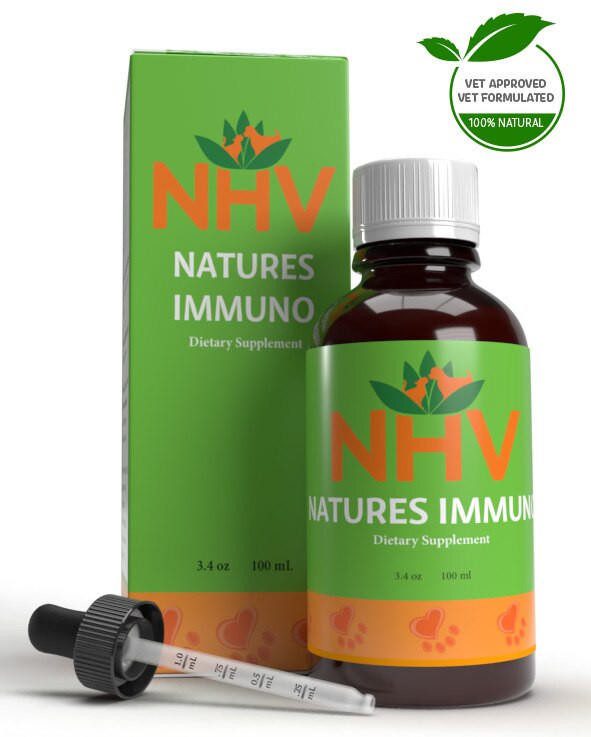
Blend of medicinal mushrooms (turkey tails, cordyceps, reishi, shiitake, agaricus)
buy 2 and save $3
3 month supply for a small to medium size pet



Medicinal mushroom blends are used by holistic and conventional veterinarians to help cats suffering from a variety of health conditions. Their immune supporting effects help with feline cancer, chronic feline infections, liver disorders, compromised immune systems, endocrine disorders, and kidney, respiratory, and cardiovascular problems.
Medicinal mushrooms are currently being researched and studied for their vast array of health benefits. NHV uses these mushrooms as a primary ingredient in supplements that support the immune system of cats.
The healing power of medicinal mushrooms has been known throughout Asia for thousands of years. The pharmacological potential of medicinal mushrooms is being extensively studied around the globe. Research is finding that specific medicinal mushrooms, like Turkey Tail mushrooms, may have the potential to help treat cancer, balance the immune system, and aid with digestive problems.
“The mounting evidence from various research groups across the globe, regarding anti-tumor application of mushroom extracts unarguably make it a fast-track research area worth mass attention.” – (Patel and Goyal, 2012)
The five well-researched mushrooms contained in our vet-formulated cat immune support supplement blend include:
Because this blend is in liquid form, it helps increase the bioavailability of the mushrooms, so your cat absorbs the medicine at a faster rate.
Use NHV’s holistic immune cancer support for cats with treatment prescribed by your vet for comprehensive care. You can always ask the experts at NHV where our pet experts are here to help answer questions, offer guidance and give support along the way.
Read more about cat immune support using the miracles of medicinal mushrooms on our blog because, at NHV, we care about your cat’s health naturally.

Turkey Tail mushroom has traditionally been used in Native American herbalism and in Chinese medicine to help improve immune function. It is a mushroom that has undergone a considerable resurgence in modern research for its health benefits. Studies have shown that it is beneficial for a wide variety of cancers, including mammary gland cancer and lymphoma. Researchers believe that Turkey Tail mushrooms contain properties that fight cancer while also helping to strengthen the immune system. It has antioxidant, anticarcinogenic, immune-modulating, anti-inflammatory, and cardioprotective properties.
Cordyceps mushroom is rich in phytonutrients and contains polysaccharides, which help with antioxidant properties. Research has indicated that cordyceps have anti-tumor, immune stimulating and hypoglycemic activity. They are beneficial for diabetes as they help lower blood sugar. Cordyceps are also beneficial for heart health, liver and kidney health.
Reishi mushroom has been used for thousands of years in traditional Chinese Medicine. Current research indicates that reishi mushrooms are helpful in supporting the immune and cardiovascular systems, as well as helping to increase oxygenation of the blood. Reishi is effective against sarcoma and tumor necrosis. Reishi is currently being used in Japan and China in conjunction with chemotherapy drugs.
Shiitake mushroom has been used for thousands of years in herbalism, and is also a popular cooking ingredient. Research indicates that Shiitake has strong antibiotic and antibacterial properties against a broad spectrum of pathogens. In addition to its potential cancer-fighting properties, it is useful in supporting heart health as it lowers cholesterol and helps lessen plaque in the arteries.
Agaricus mushroom is studied for their usefulness in preventing cancer cell production. Agaricus is considered an antimutagenic and an adaptogen, which helps combat stress and supports endocrine function. It is useful for pets with autoimmune conditions, digestive issues, and heart problems. Agaricus is being used in Japan as an adjunctive with chemotherapy treatments.
Select your pet's weight to determine the correct dose.
To be taken twice daily.
Determine your pet’s weight and then use the easy chart below to determine the correct dose. You can safely double the recommended dosage.
Pet's Weight Dosage
0 - 15 lb 0.5 mL
16 - 30 lb 1.0 mL
31 - 45 lb 1.5 mL
46 - 60 lb 2.0 mL
61 - 75 lb 2.5 mL
Over 75 lb 3.0 mL
How to Administer
Shake well before use. The easiest method is to use the dropper provided and place the drops into your pet’s food or favorite treat. You can also use the dropper and squirt directly into the pet’s mouth. Some pets can be finicky, if this occurs consider hiding the drops in foods most pet’s love such as fish, chicken, yogurt, or a favorite treat. If your pet only eats dry food then soak a few kibbles at feeding time.
For Best Results
Herbal dietary supplements are beneficial to the health and well-being of your pet and are safe for long-term use. Every pet responds to natural herbal supplements differently, therefore it is important to be consistent and administer the product daily. Supplements generally take two to four weeks to take effect, however this will vary from one animal to the next.
Product Storage
All NHV Natural Pet Products are pure herbal extracts and contain no artificial additives, preservatives or coloring. Shelf life after opening is 6 months and must be refrigerated after opening.
Medicinal mushroom blends are used by holistic and conventional veterinarians to help cats suffering from a variety of health conditions. Their immune supporting effects help with feline cancer, chronic feline infections, liver disorders, compromised immune systems, endocrine disorders, and kidney, respiratory, and cardiovascular problems.
Medicinal mushrooms are currently being researched and studied for their vast array of health benefits. NHV uses these mushrooms as a primary ingredient in supplements that support the immune system of cats.
The healing power of medicinal mushrooms has been known throughout Asia for thousands of years. The pharmacological potential of medicinal mushrooms is being extensively studied around the globe. Research is finding that specific medicinal mushrooms, like Turkey Tail mushrooms, may have the potential to help treat cancer, balance the immune system, and aid with digestive problems.
“The mounting evidence from various research groups across the globe, regarding anti-tumor application of mushroom extracts unarguably make it a fast-track research area worth mass attention.” – (Patel and Goyal, 2012)
The five well-researched mushrooms contained in our vet-formulated cat immune support supplement blend include:
Because this blend is in liquid form, it helps increase the bioavailability of the mushrooms, so your cat absorbs the medicine at a faster rate.
Use NHV’s holistic immune cancer support for cats with treatment prescribed by your vet for comprehensive care. You can always ask the experts at NHV where our pet experts are here to help answer questions, offer guidance and give support along the way.
Read more about cat immune support using the miracles of medicinal mushrooms on our blog because, at NHV, we care about your cat’s health naturally.

Turkey Tail mushroom has traditionally been used in Native American herbalism and in Chinese medicine to help improve immune function. It is a mushroom that has undergone a considerable resurgence in modern research for its health benefits. Studies have shown that it is beneficial for a wide variety of cancers, including mammary gland cancer and lymphoma. Researchers believe that Turkey Tail mushrooms contain properties that fight cancer while also helping to strengthen the immune system. It has antioxidant, anticarcinogenic, immune-modulating, anti-inflammatory, and cardioprotective properties.
Cordyceps mushroom is rich in phytonutrients and contains polysaccharides, which help with antioxidant properties. Research has indicated that cordyceps have anti-tumor, immune stimulating and hypoglycemic activity. They are beneficial for diabetes as they help lower blood sugar. Cordyceps are also beneficial for heart health, liver and kidney health.
Reishi mushroom has been used for thousands of years in traditional Chinese Medicine. Current research indicates that reishi mushrooms are helpful in supporting the immune and cardiovascular systems, as well as helping to increase oxygenation of the blood. Reishi is effective against sarcoma and tumor necrosis. Reishi is currently being used in Japan and China in conjunction with chemotherapy drugs.
Shiitake mushroom has been used for thousands of years in herbalism, and is also a popular cooking ingredient. Research indicates that Shiitake has strong antibiotic and antibacterial properties against a broad spectrum of pathogens. In addition to its potential cancer-fighting properties, it is useful in supporting heart health as it lowers cholesterol and helps lessen plaque in the arteries.
Agaricus mushroom is studied for their usefulness in preventing cancer cell production. Agaricus is considered an antimutagenic and an adaptogen, which helps combat stress and supports endocrine function. It is useful for pets with autoimmune conditions, digestive issues, and heart problems. Agaricus is being used in Japan as an adjunctive with chemotherapy treatments.
Select your pet's weight to determine the correct dose.
To be taken twice daily.
Determine your pet’s weight and then use the easy chart below to determine the correct dose. You can safely double the recommended dosage.
Pet's Weight Dosage
0 - 15 lb 0.5 mL
16 - 30 lb 1.0 mL
31 - 45 lb 1.5 mL
46 - 60 lb 2.0 mL
61 - 75 lb 2.5 mL
Over 75 lb 3.0 mL
How to Administer
Shake well before use. The easiest method is to use the dropper provided and place the drops into your pet’s food or favorite treat. You can also use the dropper and squirt directly into the pet’s mouth. Some pets can be finicky, if this occurs consider hiding the drops in foods most pet’s love such as fish, chicken, yogurt, or a favorite treat. If your pet only eats dry food then soak a few kibbles at feeding time.
For Best Results
Herbal dietary supplements are beneficial to the health and well-being of your pet and are safe for long-term use. Every pet responds to natural herbal supplements differently, therefore it is important to be consistent and administer the product daily. Supplements generally take two to four weeks to take effect, however this will vary from one animal to the next.
Product Storage
All NHV Natural Pet Products are pure herbal extracts and contain no artificial additives, preservatives or coloring. Shelf life after opening is 6 months and must be refrigerated after opening.
cancer support
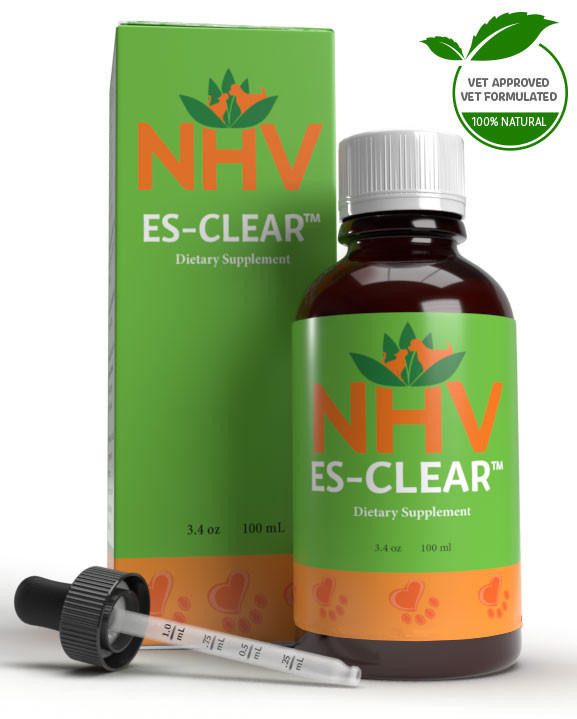
Natural cat cancer support
buy 2 and save $3
3 month supply for a small to medium size pet.
Es Clear is a 100% natural herbal pet supplement formulated by veterinarians. Feed your pet ES Clear to help support them through cancer as part of their overall holistic cat cancer treatment plan recommended by your vet.

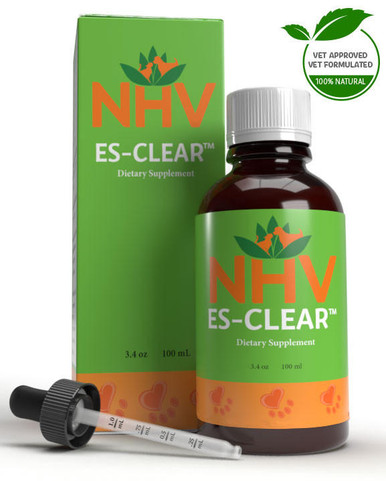
Es Clear is a 100% natural herbal pet supplement formulated by veterinarians. Feed your pet ES Clear to help support them through cancer as part of their overall holistic cat cancer treatment plan recommended by your vet.

Support your cat’s healing naturally with NHV’s ES-Clear, a well-balanced dietary supplement that is vet-approved to help manage symptoms of feline cancer. ES-Clear contains four highly effective herbs that promote health and are safe to be given long-term in conjunction with conventional treatment.
In addition, ES Clear, natural cat cancer support helps:
The potent blend of herbs found in ES-Clear will target critical areas in the body such as the kidneys, liver, stomach, major arteries as well as the spleen and lymph nodes which make this an excellent supportive cat cancer care.
NHV Natural Pet Products contains pure herbal extracts with no artificial additives, preservatives or coloring. They’re formulated by a master herbalist and holistic veterinarian with over 50 years of combined experience. You can read more about cat cancer treatments that can augment a vet-recommended cancer treatment plan on Dr. Hillary Cook's blog.
Pet parents that found ES-Clear beneficial also found Turmeric for cat cancer symptoms to be helpful. If you are unsure of which products would best help your feline family member, you can schedule a consultation because, at NHV, we want your kitty to pounce back to purrfect health naturally.
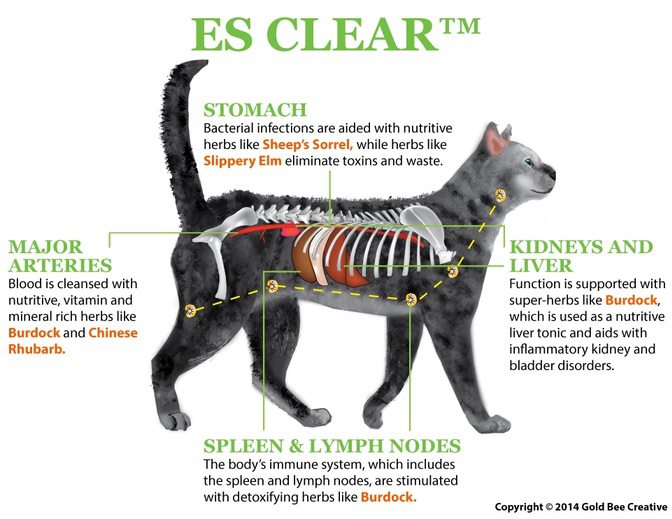
Burdock - This vitamin-rich powerful herb supports the liver, helps to clean the blood in major arteries and even has free-radical scavenging properties.
Sheep’s Sorrel - This potent herb contains a healthy source of vitamins and minerals, such as beta-carotene which is high in antioxidants.
Slippery Elm - Another vitamin and mineral-rich herb that also contains anti-inflammatory properties that aid in soothing stomach irritations which can be made worse due to the side effects of some conventional cancer medicines.
Chinese Rhubarb - Due to the powerful astringent properties of this herb, there is an increase in the removal of toxins and an improvement in gallbladder function. Chinese Rhubarb also helps the appetite, which can suffer due to the side effects of many cat cancer treatment medicines.
Select your pet's weight to determine the correct dose.
Support your cat’s healing naturally with NHV’s ES-Clear, a well-balanced dietary supplement that is vet-approved to help manage symptoms of feline cancer. ES-Clear contains four highly effective herbs that promote health and are safe to be given long-term in conjunction with conventional treatment.
In addition, ES Clear, natural cat cancer support helps:
The potent blend of herbs found in ES-Clear will target critical areas in the body such as the kidneys, liver, stomach, major arteries as well as the spleen and lymph nodes which make this an excellent supportive cat cancer care.
NHV Natural Pet Products contains pure herbal extracts with no artificial additives, preservatives or coloring. They’re formulated by a master herbalist and holistic veterinarian with over 50 years of combined experience. You can read more about cat cancer treatments that can augment a vet-recommended cancer treatment plan on Dr. Hillary Cook's blog.
Pet parents that found ES-Clear beneficial also found Turmeric for cat cancer symptoms to be helpful. If you are unsure of which products would best help your feline family member, you can schedule a consultation because, at NHV, we want your kitty to pounce back to purrfect health naturally.

Burdock - This vitamin-rich powerful herb supports the liver, helps to clean the blood in major arteries and even has free-radical scavenging properties.
Sheep’s Sorrel - This potent herb contains a healthy source of vitamins and minerals, such as beta-carotene which is high in antioxidants.
Slippery Elm - Another vitamin and mineral-rich herb that also contains anti-inflammatory properties that aid in soothing stomach irritations which can be made worse due to the side effects of some conventional cancer medicines.
Chinese Rhubarb - Due to the powerful astringent properties of this herb, there is an increase in the removal of toxins and an improvement in gallbladder function. Chinese Rhubarb also helps the appetite, which can suffer due to the side effects of many cat cancer treatment medicines.
Select your pet's weight to determine the correct dose.